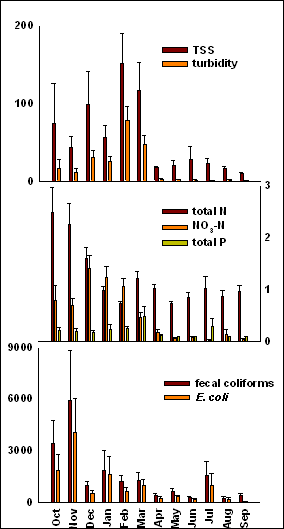Much of California’s surface drinking water and irrigation supplies are either derived from rangeland runoff, or are stored in reservoirs situated within the State’s 40 million acres of rangeland watershed. Rangeland streams provide critical habitat for a large number of aquatic and terrestrial animal species, several of which are listed as threatened or endangered by state and federal wildlife agencies. The majority of rangeland watersheds are managed for livestock production activities including grazing, pasture and meadow irrigation, and significant mileage of unimproved ranch roads.
Despite the critical importance of rangelands to the State’s surface water supply there is no published report of a comprehensive, large scale water quality survey spanning California’s major rangeland vegetation types, geologic regions, and climatic zones. Here, we report results of a two year survey of the microbiological, chemical, and physical quality of 19 rangeland streams located across California.
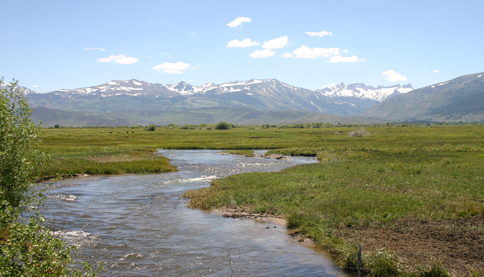
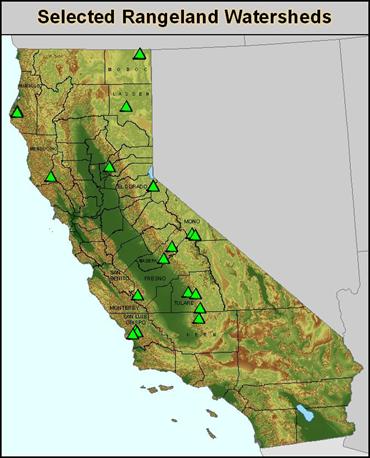
Project Objectives
- Quantify water quality from a representative sub-sample of California’s rangeland watersheds using consistent analytical methods;
- Compare these data to numeric water quality standards;
- Evaluate associations between water quality and watershed characteristics such as soil, vegetation, and hydrology; and
- Examine the data for seasonal patterns in water quality.
Study Sites
This project was a cross-sectional, longitudinal survey of 19 streams during the 2000 and 2001 water years (Oct – Sep). Watershed size ranged from 1,000 to 143,000 acres. Dominant land use was extensive range livestock production activities including livestock grazing, ranch roads, corrals, and irrigated pasture.
Data Collection
Grab samples of stream water were collected during storm runoff events, snowmelt, and summer low-flow conditions from each stream over the course of 2 years. Instantaneous streamflow was measured at the time of each sample collection using the area velocity methods. A total of 908 stream water samples collected and analyzed for: E. coli and fecal coliforms, total nitrogen (N), nitrate-nitrogen (NO3-N), ammonium-nitrogen (NH4-N), total P, phosphate-phosphorous (PO4-P), total suspended solids (TSS), electrical conductivity, and turbidity following standard methods. E. coli and fecal coliform samples were analyzed within 24 to 48 hours of collection and all data were corrected to a 24 hour holding time using a decay curve.

Water Quality Conditions
Most sites had relatively low values for all constituents, with a few sites having high values – creating an exponential distribution among sites. In general, we found concentrations of all nutrients to be low relative to state and federal water quality standards and recommended levels. Phosphate and ammonium levels were extremely low in these rangeland streams. However, fecal coliform and E. coli indictor bacteria commonly exceeded established and recommended standards. In California, fecal coliform standards range from 20 to 2000 colony forming units (cfu) per 100 milliliter (mL) of water sampled. USEPA recommends an E. coli standard of 126 cfu/100ml for an average of 5 samples collected over 30 days, or 235 cfu/100ml for a single grab sample.
Left: Box plots display the mean (red line), median (black horizontal line in box), 25th and 75th percentile (top and bottom of box), and 95th percentile (end of line) for each water quality constituent across all sites and years.
Right:Bar graphs display the mean (bar) and 1 standard error (end of line) of all samples collected over 2 years at each sample site. There appears to be an exponential distribution, with most sites having relatively low values, with a few sites having high values.
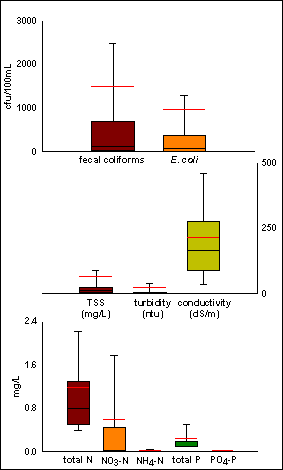
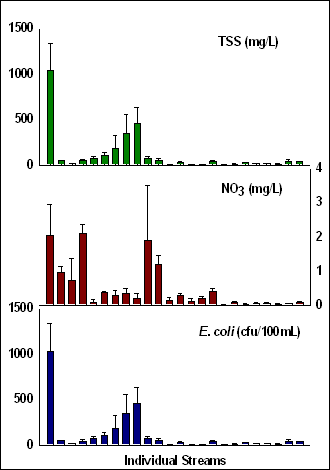
Spatial Variation
There was a clear pattern of increasing levels of these water quality constituents with increasing importance of rainfall as a streamflow generation process on the watershed. We are still examining this dataset to identify associations between water quality, vegetation type, soils, road density, and other factors.
Right: Bar graphs display the mean (bar) and 1 standard error (end of line) of all samples collected over 2 years grouped by sites that generate streamflow as a primary result of rainfall only, a combination of rainfall and snowmelt, and snowmelts only. Units for N, P, TSS are mg/L; fecal coliforms and E. coli are cfu/100mL; turbidity is ntu; and electrical conductivity is dS/m.
Seasonal Variation
We found inherent seasonality for most constituents. There were high levels of N, E. coli, and fecal coliforms early in the rainfall-runoff season, indicating these constituents are flushed from watersheds with early runoff events. Sediments (TSS) and turbidity are driven by high flow events occurring during the peak of the rainfall-runoff season in February and March. This has ramifications for monitoring strategies and estimation of background levels and enforcement of standards.
Far Right: These bar graphs display the mean (bar) and 1 standard error (line) of all samples collected over 2 years from all sites grouped by month. October is the initiation of the water year. Units for N, P, TSS are mg/L; fecal coliforms and E. coli are cfu/100mL; and turbidity is ntu.
Spatial Variation
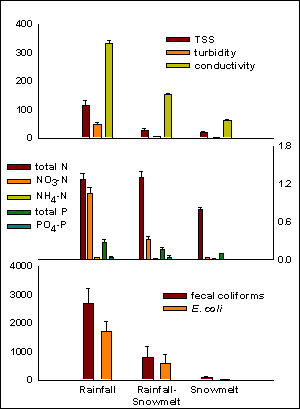
Additional Information
Ahearn, D.S., R.W. Sheibley, R.A. Dahlgren, M. Anderson, J. Johnson, and K.W. Tate. 2005. Land Use and Land Cover Influence on Water Quality in the Last Free-Flowing River Draining the Western Sierra Nevada, California. J. Hydrology. 313:234-247. Read More
Dahlgren, R.A., K.W. Tate, D.J. Lewis, E.R. Atwill, J.M. Harper, and B.H. Allen-Diaz. 2001. Watershed Research Examines Rangeland Management Effects on Water Quality. California Agriculture. 55:64-71. Read More
Henson, S., D.S. Ahearn, R.A. Dahlgren, and K.W. Tate. 2006. Water Quality to a Pulsed-Flood Flow Event on the Mokelumne River, California. Regulated Rivers. 23:185-200. Read More
Lewis, D.J., M.J. Singer, R.A. Dahlgren, and K.W. Tate. 2006. Nitrate and Sediment Fluxes from a California Rangeland Watershed. J. Environmental Quality. 35:2202-2211. Read More
Tate, K.W., R.A. Dahlgren, M.J. Singer, B. Allen-Diaz, and E.R. Atwill. 1999. On California Rangeland Watersheds: Timing, Frequency of Sampling Affect Accuracy of Water Quality Monitoring. California Agriculture. 53:44-48. Read More

